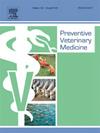Current practice and future directions in syndromic surveillance for animal health: A scoping review and analysis
IF 2.4
2区 农林科学
Q1 VETERINARY SCIENCES
引用次数: 0
Abstract
Syndromic surveillance, the monitoring of non-specific indicators or symptoms, is a powerful tool for monitoring health or well-being. We conducted a scoping review to provide an up-to-date, global overview of syndromic surveillance for animal health, focusing on variation between animal sectors (livestock, companion, and wildlife), geography, indicators, data providers, and One Health approaches. We searched the Scopus and PubMed databases for articles describing or using data from syndromic surveillance systems or testing the potential of a data set or method for syndromic surveillance and supplemented this information with gray literature to determine further development of systems. We identified 126 syndromic surveillance systems from 165 articles. Most systems (n = 84, 67 %) were in the proof-of-concept phase, while only 25 (20 %) were established operational systems. These were mostly run by governments (n = 15, 58 %), as well as nonprofits (n = 4, 15 %), and academic institutions (n = 3, 12 %). The majority of systems monitored livestock (n = 89, 71 %); just over half were located in Europe (n = 64, 51 %) and a further 28 % (n = 35) in North America. Only eight systems (6 %) monitored multiple animal sectors. Twelve systems (10 %) used a One Health approach, linking data or surveillance concerning the same threat in humans and any animal sector. The most common data collectors were private veterinarians (n = 35, 28 %) and animals' owners (n = 29, 23 %); the most commonly used indicators were mortality (n = 52, 41 %), general illness (n = 36, 29 %), and reproductive symptoms (n = 31, 25 %). While syndromic surveillance for animals continues to develop, there is still a gap between research and implementation. However, even established systems are vulnerable to lack of continued funding and support. By compiling and analyzing this data, we highlight developments in syndromic surveillance for animals as well as differences in practices between sectors and regions of the world.
动物卫生综合征监测的当前实践和未来方向:范围回顾和分析
综合征监测,即对非特异性指标或症状的监测,是监测健康或福祉的有力工具。我们进行了一项范围审查,以提供最新的全球动物卫生综合征监测概况,重点关注动物部门(牲畜、伴侣和野生动物)、地理、指标、数据提供者和One health方法之间的差异。我们在Scopus和PubMed数据库中搜索描述或使用综合征监测系统数据的文章,或测试综合征监测数据集或方法的潜力的文章,并用灰色文献补充这些信息,以确定系统的进一步发展。我们从165篇文章中确定了126个综合征监测系统。大多数系统(n = 84,67 %)处于概念验证阶段,而只有25个(20 %)建立了操作系统。这些大多是由政府(n = 15日,58 %),以及非营利组织(n = 4,15 %),和学术机构(n = 3,12 %)。大多数系统监测牲畜(n = 89,71 %);超过一半位于欧洲(n = 64,51 %),另外28 % (n = 35)位于北美。只有8个系统(6 %)监测多个动物部门。12个系统(10 %)采用“同一个卫生”方法,将涉及人类和任何动物部门的同一威胁的数据或监测联系起来。最常见的数据收集者是私人兽医(n = 35,28 %)和动物主人(n = 29,23 %);最常用的指标是死亡率(n = 52岁41 %),一般疾病(n = 36岁,29 %),和生殖症状(n = 31日25 %)。虽然动物综合征监测继续发展,但研究与实施之间仍存在差距。然而,即使是已建立的系统也容易受到缺乏持续资金和支持的影响。通过汇编和分析这些数据,我们强调了动物综合征监测方面的进展以及世界各部门和地区在做法上的差异。
本文章由计算机程序翻译,如有差异,请以英文原文为准。
求助全文
约1分钟内获得全文
求助全文
来源期刊

Preventive veterinary medicine
农林科学-兽医学
CiteScore
5.60
自引率
7.70%
发文量
184
审稿时长
3 months
期刊介绍:
Preventive Veterinary Medicine is one of the leading international resources for scientific reports on animal health programs and preventive veterinary medicine. The journal follows the guidelines for standardizing and strengthening the reporting of biomedical research which are available from the CONSORT, MOOSE, PRISMA, REFLECT, STARD, and STROBE statements. The journal focuses on:
Epidemiology of health events relevant to domestic and wild animals;
Economic impacts of epidemic and endemic animal and zoonotic diseases;
Latest methods and approaches in veterinary epidemiology;
Disease and infection control or eradication measures;
The "One Health" concept and the relationships between veterinary medicine, human health, animal-production systems, and the environment;
Development of new techniques in surveillance systems and diagnosis;
Evaluation and control of diseases in animal populations.
 求助内容:
求助内容: 应助结果提醒方式:
应助结果提醒方式:


